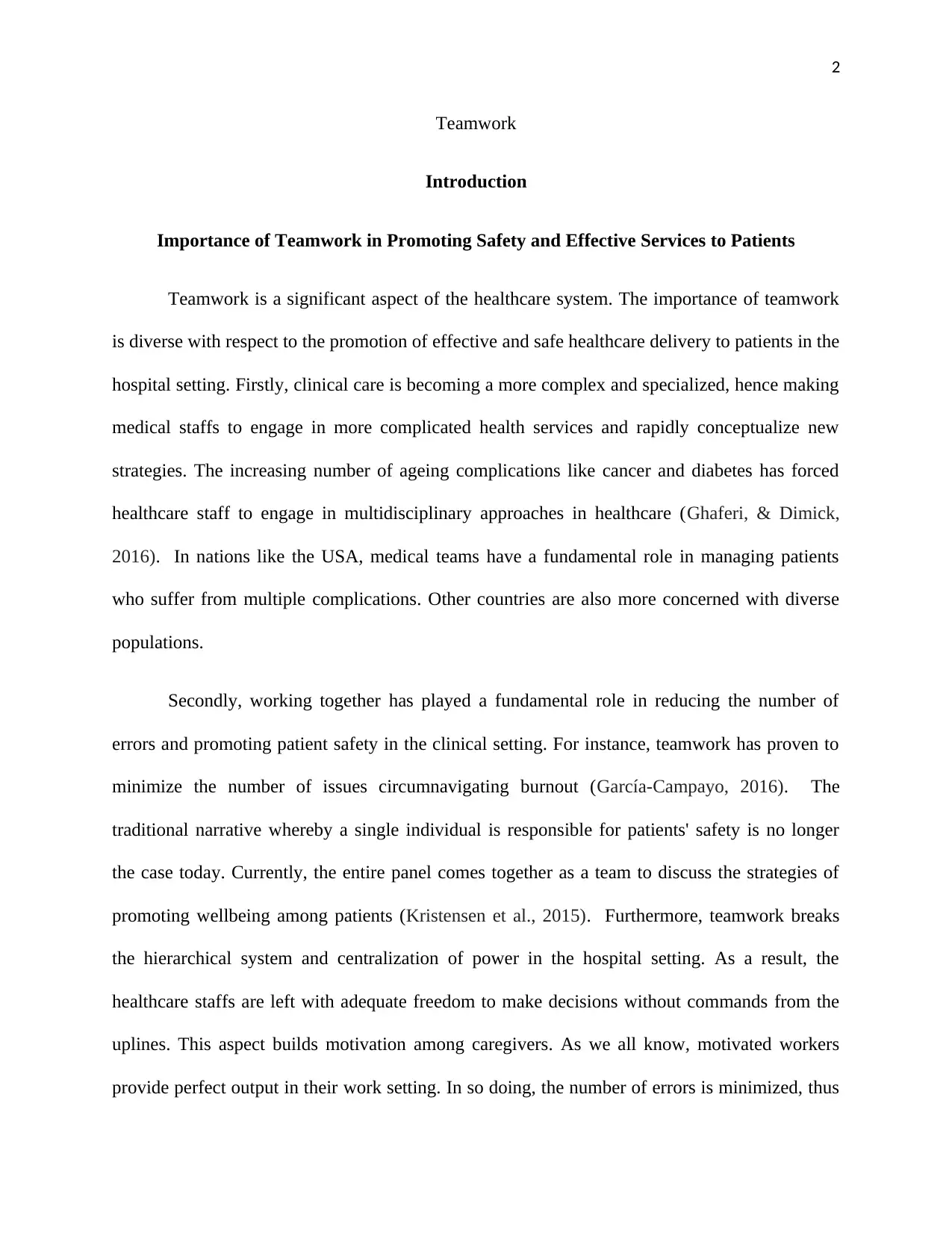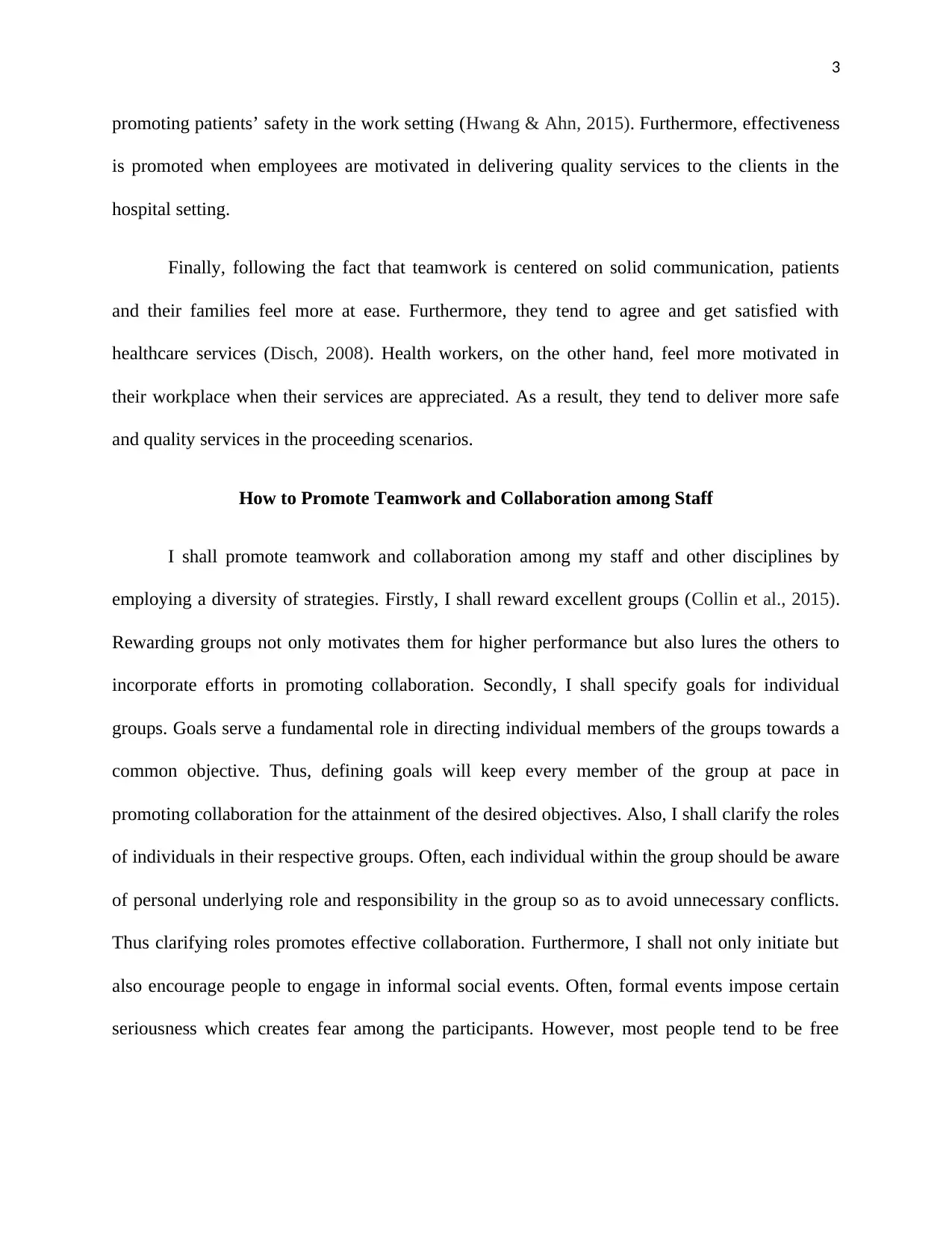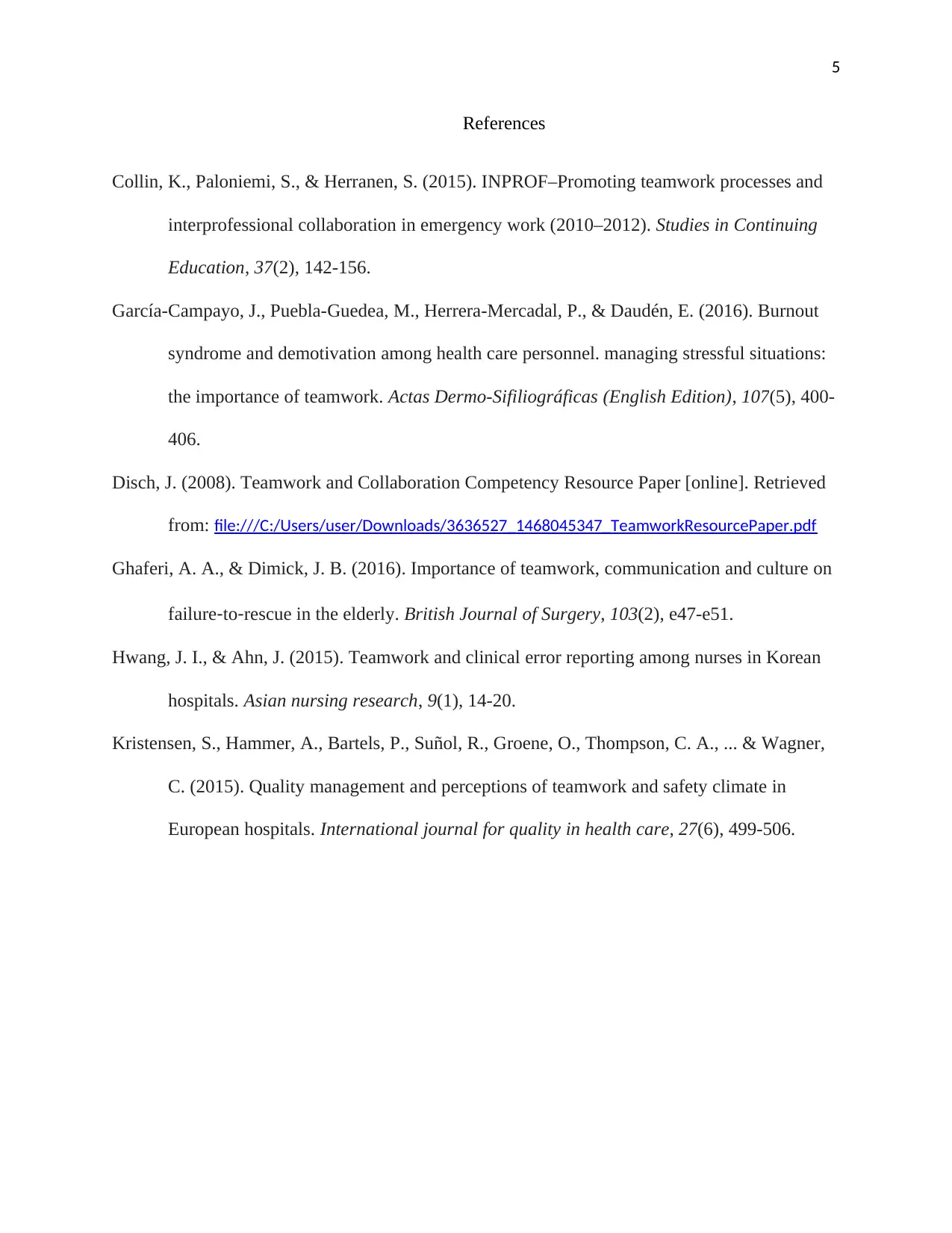Importance of Teamwork in Promoting Patient Safety and Services
VerifiedAdded on 2022/10/19
|5
|903
|9
Report
AI Summary
This report emphasizes the critical role of teamwork in the healthcare system, highlighting its impact on promoting patient safety and effective service delivery. It explores how teamwork reduces errors, minimizes burnout, and fosters open communication, ultimately leading to improved patient outcomes and satisfaction. The report also discusses strategies to promote teamwork and collaboration among healthcare staff, such as rewarding group performance, defining individual goals and roles, and encouraging informal social events. The author emphasizes the need for a multidisciplinary approach to address complex patient needs and the importance of a collaborative environment to ensure quality care. References are provided to support the claims made in the report.

Running head: TEAMWORK 1
Teamwork
Student’s Name
Institutional Affiliation
Teamwork
Student’s Name
Institutional Affiliation
Paraphrase This Document
Need a fresh take? Get an instant paraphrase of this document with our AI Paraphraser

2
Teamwork
Introduction
Importance of Teamwork in Promoting Safety and Effective Services to Patients
Teamwork is a significant aspect of the healthcare system. The importance of teamwork
is diverse with respect to the promotion of effective and safe healthcare delivery to patients in the
hospital setting. Firstly, clinical care is becoming a more complex and specialized, hence making
medical staffs to engage in more complicated health services and rapidly conceptualize new
strategies. The increasing number of ageing complications like cancer and diabetes has forced
healthcare staff to engage in multidisciplinary approaches in healthcare (Ghaferi, & Dimick,
2016). In nations like the USA, medical teams have a fundamental role in managing patients
who suffer from multiple complications. Other countries are also more concerned with diverse
populations.
Secondly, working together has played a fundamental role in reducing the number of
errors and promoting patient safety in the clinical setting. For instance, teamwork has proven to
minimize the number of issues circumnavigating burnout (García-Campayo, 2016). The
traditional narrative whereby a single individual is responsible for patients' safety is no longer
the case today. Currently, the entire panel comes together as a team to discuss the strategies of
promoting wellbeing among patients (Kristensen et al., 2015). Furthermore, teamwork breaks
the hierarchical system and centralization of power in the hospital setting. As a result, the
healthcare staffs are left with adequate freedom to make decisions without commands from the
uplines. This aspect builds motivation among caregivers. As we all know, motivated workers
provide perfect output in their work setting. In so doing, the number of errors is minimized, thus
Teamwork
Introduction
Importance of Teamwork in Promoting Safety and Effective Services to Patients
Teamwork is a significant aspect of the healthcare system. The importance of teamwork
is diverse with respect to the promotion of effective and safe healthcare delivery to patients in the
hospital setting. Firstly, clinical care is becoming a more complex and specialized, hence making
medical staffs to engage in more complicated health services and rapidly conceptualize new
strategies. The increasing number of ageing complications like cancer and diabetes has forced
healthcare staff to engage in multidisciplinary approaches in healthcare (Ghaferi, & Dimick,
2016). In nations like the USA, medical teams have a fundamental role in managing patients
who suffer from multiple complications. Other countries are also more concerned with diverse
populations.
Secondly, working together has played a fundamental role in reducing the number of
errors and promoting patient safety in the clinical setting. For instance, teamwork has proven to
minimize the number of issues circumnavigating burnout (García-Campayo, 2016). The
traditional narrative whereby a single individual is responsible for patients' safety is no longer
the case today. Currently, the entire panel comes together as a team to discuss the strategies of
promoting wellbeing among patients (Kristensen et al., 2015). Furthermore, teamwork breaks
the hierarchical system and centralization of power in the hospital setting. As a result, the
healthcare staffs are left with adequate freedom to make decisions without commands from the
uplines. This aspect builds motivation among caregivers. As we all know, motivated workers
provide perfect output in their work setting. In so doing, the number of errors is minimized, thus

3
promoting patients’ safety in the work setting (Hwang & Ahn, 2015). Furthermore, effectiveness
is promoted when employees are motivated in delivering quality services to the clients in the
hospital setting.
Finally, following the fact that teamwork is centered on solid communication, patients
and their families feel more at ease. Furthermore, they tend to agree and get satisfied with
healthcare services (Disch, 2008). Health workers, on the other hand, feel more motivated in
their workplace when their services are appreciated. As a result, they tend to deliver more safe
and quality services in the proceeding scenarios.
How to Promote Teamwork and Collaboration among Staff
I shall promote teamwork and collaboration among my staff and other disciplines by
employing a diversity of strategies. Firstly, I shall reward excellent groups (Collin et al., 2015).
Rewarding groups not only motivates them for higher performance but also lures the others to
incorporate efforts in promoting collaboration. Secondly, I shall specify goals for individual
groups. Goals serve a fundamental role in directing individual members of the groups towards a
common objective. Thus, defining goals will keep every member of the group at pace in
promoting collaboration for the attainment of the desired objectives. Also, I shall clarify the roles
of individuals in their respective groups. Often, each individual within the group should be aware
of personal underlying role and responsibility in the group so as to avoid unnecessary conflicts.
Thus clarifying roles promotes effective collaboration. Furthermore, I shall not only initiate but
also encourage people to engage in informal social events. Often, formal events impose certain
seriousness which creates fear among the participants. However, most people tend to be free
promoting patients’ safety in the work setting (Hwang & Ahn, 2015). Furthermore, effectiveness
is promoted when employees are motivated in delivering quality services to the clients in the
hospital setting.
Finally, following the fact that teamwork is centered on solid communication, patients
and their families feel more at ease. Furthermore, they tend to agree and get satisfied with
healthcare services (Disch, 2008). Health workers, on the other hand, feel more motivated in
their workplace when their services are appreciated. As a result, they tend to deliver more safe
and quality services in the proceeding scenarios.
How to Promote Teamwork and Collaboration among Staff
I shall promote teamwork and collaboration among my staff and other disciplines by
employing a diversity of strategies. Firstly, I shall reward excellent groups (Collin et al., 2015).
Rewarding groups not only motivates them for higher performance but also lures the others to
incorporate efforts in promoting collaboration. Secondly, I shall specify goals for individual
groups. Goals serve a fundamental role in directing individual members of the groups towards a
common objective. Thus, defining goals will keep every member of the group at pace in
promoting collaboration for the attainment of the desired objectives. Also, I shall clarify the roles
of individuals in their respective groups. Often, each individual within the group should be aware
of personal underlying role and responsibility in the group so as to avoid unnecessary conflicts.
Thus clarifying roles promotes effective collaboration. Furthermore, I shall not only initiate but
also encourage people to engage in informal social events. Often, formal events impose certain
seriousness which creates fear among the participants. However, most people tend to be free
⊘ This is a preview!⊘
Do you want full access?
Subscribe today to unlock all pages.

Trusted by 1+ million students worldwide

4
within informal events hence promoting understanding of each other which ultimately promote
effective collaboration.
within informal events hence promoting understanding of each other which ultimately promote
effective collaboration.
Paraphrase This Document
Need a fresh take? Get an instant paraphrase of this document with our AI Paraphraser

5
References
Collin, K., Paloniemi, S., & Herranen, S. (2015). INPROF–Promoting teamwork processes and
interprofessional collaboration in emergency work (2010–2012). Studies in Continuing
Education, 37(2), 142-156.
García-Campayo, J., Puebla-Guedea, M., Herrera-Mercadal, P., & Daudén, E. (2016). Burnout
syndrome and demotivation among health care personnel. managing stressful situations:
the importance of teamwork. Actas Dermo-Sifiliográficas (English Edition), 107(5), 400-
406.
Disch, J. (2008). Teamwork and Collaboration Competency Resource Paper [online]. Retrieved
from: file:///C:/Users/user/Downloads/3636527_1468045347_TeamworkResourcePaper.pdf
Ghaferi, A. A., & Dimick, J. B. (2016). Importance of teamwork, communication and culture on
failure‐to‐rescue in the elderly. British Journal of Surgery, 103(2), e47-e51.
Hwang, J. I., & Ahn, J. (2015). Teamwork and clinical error reporting among nurses in Korean
hospitals. Asian nursing research, 9(1), 14-20.
Kristensen, S., Hammer, A., Bartels, P., Suñol, R., Groene, O., Thompson, C. A., ... & Wagner,
C. (2015). Quality management and perceptions of teamwork and safety climate in
European hospitals. International journal for quality in health care, 27(6), 499-506.
References
Collin, K., Paloniemi, S., & Herranen, S. (2015). INPROF–Promoting teamwork processes and
interprofessional collaboration in emergency work (2010–2012). Studies in Continuing
Education, 37(2), 142-156.
García-Campayo, J., Puebla-Guedea, M., Herrera-Mercadal, P., & Daudén, E. (2016). Burnout
syndrome and demotivation among health care personnel. managing stressful situations:
the importance of teamwork. Actas Dermo-Sifiliográficas (English Edition), 107(5), 400-
406.
Disch, J. (2008). Teamwork and Collaboration Competency Resource Paper [online]. Retrieved
from: file:///C:/Users/user/Downloads/3636527_1468045347_TeamworkResourcePaper.pdf
Ghaferi, A. A., & Dimick, J. B. (2016). Importance of teamwork, communication and culture on
failure‐to‐rescue in the elderly. British Journal of Surgery, 103(2), e47-e51.
Hwang, J. I., & Ahn, J. (2015). Teamwork and clinical error reporting among nurses in Korean
hospitals. Asian nursing research, 9(1), 14-20.
Kristensen, S., Hammer, A., Bartels, P., Suñol, R., Groene, O., Thompson, C. A., ... & Wagner,
C. (2015). Quality management and perceptions of teamwork and safety climate in
European hospitals. International journal for quality in health care, 27(6), 499-506.
1 out of 5
Related Documents
Your All-in-One AI-Powered Toolkit for Academic Success.
+13062052269
info@desklib.com
Available 24*7 on WhatsApp / Email
![[object Object]](/_next/static/media/star-bottom.7253800d.svg)
Unlock your academic potential
Copyright © 2020–2025 A2Z Services. All Rights Reserved. Developed and managed by ZUCOL.





